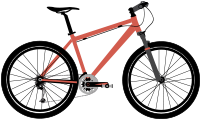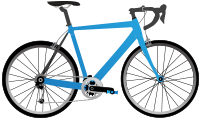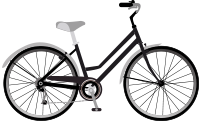Exercise doesn’t come much more convenient than cycling. An efficient method of transportation and a workout. What’s not to like? Whether you use it to get to work or college, or want to explore the sights of city or nature, cycling is versatile, fun, liberating, kind to mother earth, and – except for the bike – free.
Cycling for Fitness
Cycling is a different kind of workout, it allows you to get out and explore the world under the guise of exercise. Because you can travel quite a long way in a relatively short time, you can train in places to which you might not otherwise never venture.
Cycling for fitness is not unlike running or swimming for fitness in that you can alter your speed and regulate your workout duration according to your current level of fitness and your training goals. You can use all the usual cardiovascular training methods when cycling including:
Cycling can also be a very sociable activity and cyclists often train in groups. It’s not uncommon for long rides to be punctuated with a stop at a café for a drink and a snack. And it’s a great form of cardiovascular exercise and is low-impact.
How to Choose a Bike
There are various types of bikes. If you’re looking to get fit, just about any kind of bike will do – mountain, road or hybrid. Each has advantages and disadvantages so it’s really a case of either making do with what you’ve got or selecting a bike based on the type of cycling you’re most likely going to do, i.e. where and how you plan to cycle.
- Paved roads or bike paths – Road bike or hybrid bike
- Pavement or natural surfaces – Hybrid bike
- All-road riding – Touring bike
- Dirt roads or trails – Mountain bike
Mountain Bikes

With the exception of top-price models, mountain bikes tend to be heavier than road bikes. This is because they are made to be tough and durable so they can survive the rigors of riding off road.
Most mountain bikes offer a large number of gears so you can conquer almost any incline and the upright riding position can make for a more comfortable ride as well as making it easier to look ahead without getting neck ache. However, this upright position is less aerodynamic so you’ll have to work harder to reach high speeds than on a more low profile road bike.
Suspension, a feature of many mountain bikes, is great if you are going to spend a lot of time off road but the flexibility of the frame and/or forks will also absorb a significant part of your pedaling energy and mean that you will lose some speed on the road.
Tip: If you intend to use your mountain bike on the road, it’s worth considering fitting it with low profile road tires to minimize rolling resistance. Road tires are much smoother than knobbly off-road tires and will allow you to go further and faster with less effort. There are also tires designed for mixed terrain – another good option.
Good for: If you plan to head out for adventures on dirt roads or trails. It’s also a good choice for novice or occasional cyclists, given that mountain bikes tend to feel very stable due to the riding position and smaller, wider wheels compared to a road bike.
Road Bikes

As the name suggests, road bikes are designed to be ridden on the road. They are characterized by their narrow tires, “drop” handlebars and bent over riding position.
The aerodynamic riding position, combined with generally a lighter machine, means that road bikes tend to be faster than mountain bikes although obviously this ultimately depends on the fitness of the rider.
Road bikes are normally fitted with very narrow, smooth tires to further maximize speed. The narrow wheels further reduce road contact and therefore friction. While narrow wheels and smooth tires can enhance speed, it does mean that a road bike is out of its element on anything other than smooth roads in good condition. Hitting a pot hole at twenty-miles per hour is very likely to destroy a road bike wheel whereas a mountain bike will probably just bounce over it.
Tip: Some cyclists find riding in a tucked position uncomfortable initially. To limit this you should make sure your bike is set up properly and the handle bars are not too low. Also, make sure your frame is the right size for you and, if you are serious about cycling, consider getting a customized frame made so the bike geometry is matched to your unique body shape.
Good for: If covering long distances at speed is your aim, a road bike is probably your best choice but if you ride on rough roads or are considering riding off road, a mountain bike is the better choice.
Hybrid Bikes

Sometimes called commuter bikes or fitness bikes, unsurprisingly, hybrids are the successful marriage of road bikes and mountain bikes.
Basically a mountain bike frame with larger, low profile wheels, hybrids are popular with courier riders as they are fast, agile, comfortable and tough; not as tough as a fully-fledged mountain bile but certainly up to the challenge of even the most poorly maintained roads.
While definitely faster than a typical mountain bike (again, depending on the fitness of the rider) the comfortable upright riding position will increase your aerodynamic drag so bare this in mind if speed is one of your cycling requirements.
Good for: A hybrid bike is ideal if you want versatility and comfort, but don’t want to completely loose on-road performance. This makes it a good choice if you’re a commuter or cycle around town and like to occasionally go off road.
Touring Bikes
Touring bikes are super versatile, do-everything bikes that are durable, comfortable, and stable – designed to be ridden over multiple days or long distances, while carrying a heavy load. It’s versatility means this bike is great for everyone from beginner cyclists and commuters to touring cyclists.
Basically a beefed up classic road bike, touring bikes have a retro look and still sport a drop handlebar, albeit one with a more relaxed design allowing for a more upright and comfortable position.
Designed to carry heavy loads, the touring bike also boasts pannier racks, a lower gear range than road bikes to ride steep hills, and slightly wider tyres.
Good for: Study, comfortable, and built for carrying loads over long distances, this bike is ideal if you’re a commuter, plan on riding long distances, or simply need to carry a whole lot of stuff on your bike.
Exercise Bikes

While cycling outdoors is great exercise, it’s not without drawbacks. Bad weather or heavy traffic can all put a cramp on your cycling ambitions. An indoor exercise bike may be the answer.
There are numerous styles of exercise bikes. Some use a large electromagnet to provide pedalling resistance while others use a simple flywheel and belt system.
Alternatively, you can buy rollers and devices called “turbo trainers” that will convert your regular bike into an exercise machine. Turbo trainers provide an excellent way to perform intervals in a safe and easily quantifiable environment.
Good for: Bad weather? No problem! Park your bike in front of the TV and simply spin away. A major plus side for exercise bikes is that they are very quiet in use which makes them ideal if you have thin walls or neighbors with good hearing!
Best Cycling Gear for Beginners
In addition to a bike, there are a few other things to buy or consider to make cycling as productive, safe and fun as possible…
Helmet
Bones mend, brains don’t. A helmet is non-negotiable. If you don’t want to wear a helmet, don’t cycle. In almost every case, it’s the cyclist who’ll lose and end up injured in a clash with another vehicle, a pothole or a road sign. It’s all too easy to just fall off if you hit an oily patch on the road or wet leaves, and fall awkwardly.
Cycling without a helmet is akin to Russian Roulette. Don’t play it. Protect your most vital organ by always wearing a helmet designed specifically for cycling.
Modern helmets are light, well ventilated and very effective at directing impact forces away from your fragile skull and brain. Do not skimp on this vital piece of equipment!
Cycling Clothes
Comfort and visibility are key. If you spend long enough on a bike, you’ll soon understand why cycling shorts look as they do and are made with reinforced seats which are generally padded.
Believe it or not, cycling shorts are not synonymous with figure hugging Lycra; you can also get cargo/skateboard style cycling shorts.
As for the rest of your cycling wardrobe? Just dress for the elements as you would with any outdoor workout. Remember that wind chill will be a factor, and while your legs may stay warm, your feet, hands and head/face can get painfully cold very quickly. Overshoes, gloves and a hat are all but essential clothing items for cold weather cycling.
Clipless Pedals & Shoes
If you’re planning to really get into cycling, clipless shoes are worth buying. Regular exercise shoes are fine, but all that spongy shock absorbency will soak up some of your pedaling effort and waste your valuable energy.
Also, cycling fast and efficiently is more than just stamping downwards on your pedals; you should also be pushing forwards, pulling back and pulling up. This means you need to be attached to your pedals.
Being fixed to your bike takes some getting used to so don’t venture out into traffic until you are completely comfortable with your shoe and pedal connection. The last thing you want to do is pull up at a set of traffic lights and then find you can’t disengage your foot from the pedal. Falling down in the street is seldom cool and definitely not safe.
Cycling Safety for New Cyclists
Courier riders are notoriously foolhardy and weave in and out of traffic with seemingly complete disregard for their safety. More often than not they leave a trail of angry motorists in their wake. However, just because many bike messengers seem to have delusions of immortality, doesn’t mean you need to ride as they do.
Even with your compulsory helmet firmly in place, you are literally putting your life on the line if you fail to observe the rules of the road.
So, NO to:
- jumping traffic lights
- riding on the pavement
- riding without lights at night
- forgetting your high visibility jacket if you are riding at night
- listening to music or anything else that will stop you hearing the approach of traffic
- riding aggressively or provocatively.
The best tactic for riding as safely as possible is to ride defensively. Always be on your guard and assume motor vehicle drivers have not seen you approaching. Do that and you’ll reduce your risks of suffering an accident.
Read more: How to cycle safely on the road
Bike Maintenance: Carry a Repair Kit
Punctures and mechanical problems happen, and they are super inconvenient. There is nothing worse than getting half way through a two-hour bike ride, suffering a blow out and then having to walk your bike all the way home.
Make it less inconvenient and always carry a rudimentary repair kit including one or two spare inner tubes with you so you can fix a puncture, adjust your gears or carry out any other emergency repairs that will allow you to make your way home.
Cycling is not just great exercise; it’s an environmentally friendly way to get from A to Z. Once you have bought your bike and the necessary equipment, cycling is a also cheap workout and provides the means to getting out and about and exercising in places you might not otherwise visit. If you want to really catch the cycling bug, consider joining one of the many cycling clubs around.

